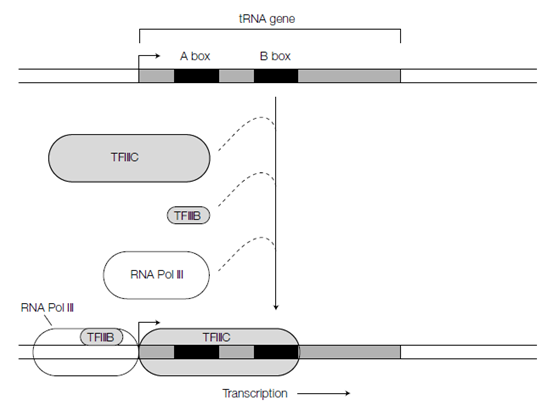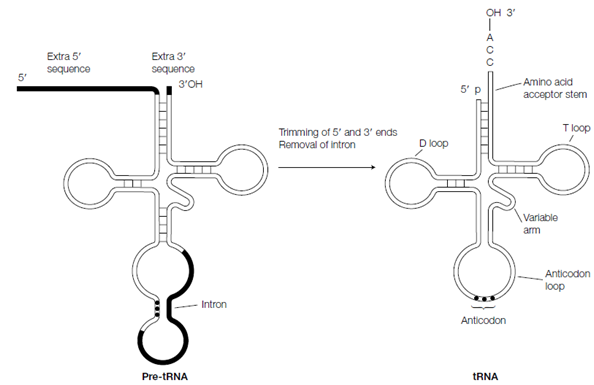Transcription and processing of tRNA in eukaryotes:
In the eukaryotes, the transfer RNA genes exist as multiple copies and are transcribed by RNA polymerase III or RNA Pol III. As in prokaryotes, several tRNAs may be transcribed together to yield a single pre- transfer RNA molecule that is then processed to release the mature transfer RNAs. The promoters of eukaryotic transfer RNA genes are commonly in which the transcriptional control components are situated downstream example for on the 3' side of the transcriptional start site (at position + 1). In reality they lie within the gene itself. Two such components have been recognized, known the A box and B box. The Transcription of the transfer RNA genes through RNA Pol III needs transcription factor IIIC (TFIIIC) as well as TFIIIB. The TFIIIC binds to the A and B boxes whilst TFIIIB binds upstream of the A box. TFIIIB holds three subunits, one of that is TBP (TATA binding protein), the polypeptide needed through all three eukaryotic RNA polymerases.
After the synthesis, the pre-transfer RNA molecule folds up into the characteristic stem- loops structures describe in the figure and non-tRNA sequence is cleaved from the 5' and 3' ends through ribonucleases. In the prokaryotes the CCA sequence at the 3' end of the tRNA (that is the site of bonding to the amino acid) is enclosed through the tRNA gene but this is not the case in eukaryotes. Alternatively, the CCA is added to the 3' end after the trimming reactions through tRNA nucleotidyl transferase. Another

Figure: Initiation of transcription of a tRNA gene by RNA Pol III.

Figure: Processing of a typical eukaryotic pre-tRNA molecule.
difference among eukaryotes and prokaryotes is which eukaryotic pre-transfer RNA molecules frequently hold a short intron in the loop of the anticodon arm describe in the figure. This intron must be erased in order to build a functional tRNA molecule. Its removal occurs through cleavage through a tRNA splicing endonuclease at every end of the intron and then ligation together of the tRNA ends through tRNA ligase. This RNA splicing pathway for intron erased is fully variant from that used to erase introns from pre-mRNA molecules in eukaryotes and must have evolved independently.